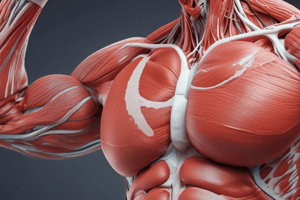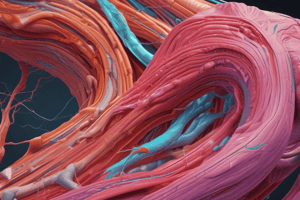Podcast
Questions and Answers
The muscular system has three types of muscle tissue.
The muscular system has three types of muscle tissue.
True (A)
Skeletal muscle fibers contract partially when stimulated.
Skeletal muscle fibers contract partially when stimulated.
False (B)
Small motor units are composed of fast-twitch white fibers.
Small motor units are composed of fast-twitch white fibers.
False (B)
The sliding filament mechanism explains how muscle fibers contract.
The sliding filament mechanism explains how muscle fibers contract.
Red muscle fibers are typically associated with fast and explosive movements.
Red muscle fibers are typically associated with fast and explosive movements.
Motor units within a muscle can consist of both red and white fibers.
Motor units within a muscle can consist of both red and white fibers.
The nervous system controls muscle contraction through electrical impulses.
The nervous system controls muscle contraction through electrical impulses.
Normal muscle length has no relation to muscle tone.
Normal muscle length has no relation to muscle tone.
The microanatomy of a muscle fiber is primarily composed of adipose tissue.
The microanatomy of a muscle fiber is primarily composed of adipose tissue.
Therapeutic exercises are not part of physical therapist interventions.
Therapeutic exercises are not part of physical therapist interventions.
Study Notes
Functions of the Muscular System
- Movement, posture, heat production, fluid movement, and support
Three Types of Muscle Tissue
- Skeletal Muscle: Voluntary, striated (striped pattern), attached to bones by tendons
- Responsible for body movement, posture maintenance
- Smooth Muscle: Involuntary, non-striated (no striped pattern)
- Found in various organs like the stomach, bladder, blood vessels
- Responsible for functions like digestion, blood pressure regulation
- Cardiac Muscle: Involuntary, striated (striped pattern), found only in the heart
- Responsible for heart contractions, pumping blood throughout the body
Myofascial Unit
- Includes the muscle fibers and their connective tissues (fascia)
Microanatomy of a Muscle Fiber
- Sarcolemma: Cell membrane surrounding a muscle fiber
- Sarcoplasm: Cytoplasm of a muscle fiber containing organelles and the protein myoglobin
- Myofibrils: Specialized organelles within a muscle fiber that contain the contractile proteins actin and myosin
Sliding Filament Mechanism
- Muscle contraction occurs by the sliding of the thin filaments (actin) over the thick filaments (myosin)
- Actin: Thin filament, contains binding sites for myosin
- Myosin: Thick filament, has a head region that binds to actin and pulls it toward the center of the sarcomere
- ATP: Energy source required for the myosin heads to detach from actin and reattach, continuing the sliding process
- Calcium: Activates the sliding filament mechanism by binding to troponin, which moves tropomyosin away from the active sites on actin, allowing myosin to bind
Nervous System Control of Muscle Contraction
- Motor Neuron: A nerve cell that transmits impulses from the brain or spinal cord to muscle fibers
- Synapse: The junction between a motor neuron and a muscle fiber
- Neurotransmitter: A chemical released by the motor neuron at the synapse, acetylcholine, which stimulates the muscle fiber to contract
Motor Unit
- A motor neuron and all the muscle fibers it innervates
- Size of a motor unit can vary, affecting the precision and power of a muscle
All or None Response Law
- A muscle fiber will contract completely if it receives an electrical impulse, otherwise, it will remain relaxed
Red and White Muscle Fibers
- Red Fibers (Slow-twitch):
- Fatigue-resistant, rely on oxygen for energy
- Used for endurance activities
- White Fibers (Fast-twitch):
- Fatigue quickly, rely on anaerobic metabolism
- Used for short bursts of power and speed
- Motor units are composed of homogeneous fibers, either all red or all white
Studying That Suits You
Use AI to generate personalized quizzes and flashcards to suit your learning preferences.
Related Documents
Description
Explore the essential functions of the muscular system, including movement, posture, and heat production. Learn about the three types of muscle tissue: skeletal, smooth, and cardiac, along with the microanatomy of a muscle fiber. This quiz will test your knowledge about the structure and function of muscles in the human body.




